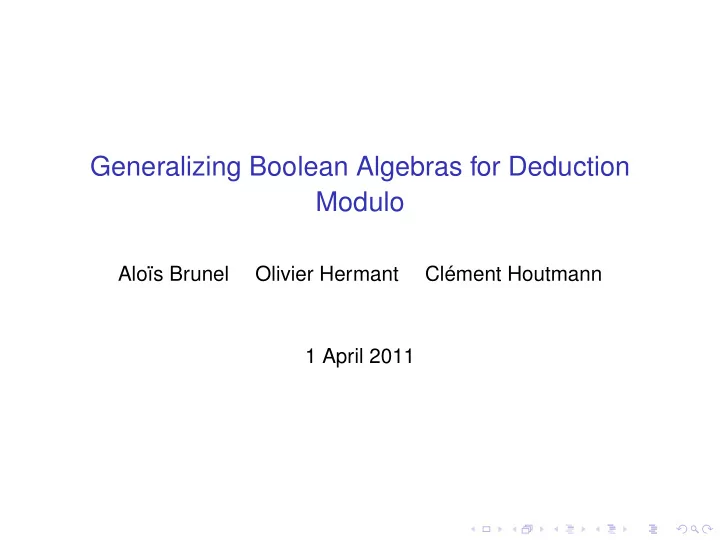

Generalizing Boolean Algebras for Deduction Modulo Aloïs Brunel Olivier Hermant Clément Houtmann 1 April 2011
Introduction ◮ extend the notion of superconsistency ◮ consistency: A theory A is consistent if there exists a model M in which there exists an interpretation � _ � where: � A � � ⊥ ◮ super-consistency: A theory A is super-consistent if for all model M , there exists an interpretation � _ � where: � A � � ⊤
Superconsistency ◮ what is a theory ? ◮ rewriting systems of Deduction Modulo ◮ a congruence on propositions generated by a set of rewrite rules x + 0 −→ 0 P ( 0 ) ∀ xP ( x ) −→ ◮ what is a model ? ◮ intuitionistic setting: Heyting algebras ◮ need to generalize over it: pre -Heyting algebras (plus technical conditions) ◮ pre-Heyting algebras are still sound and complete ◮ what do we get ? ◮ reducibility candidates are a pre-Heyting algebra (and not a Heyting algebra) ◮ all super-consistent theories have the normalization property
◮ extend the notion of super-consistency ◮ to classical logic ◮ to sequent calculus ◮ to proofs of cut admissibility ◮ of course, super-consistency implies cut-admissibility in classical sequent calculus modulo. ◮ but through a ¬¬ -translation and a back and forth translation in Natural Deduction [Dowek-Werner] ◮ direct proof wanted
Introduction ◮ the framework: ◮ monolateral classical sequent calculus ◮ deduction modulo with explicit conversion rule ◮ negation is an operation and not a connector: ( A ∧ B ) ⊥ = A ⊥ ∧ B ⊥ ◮ the method: sequent reducibility candidates [Dowek, Hermant] .
Pre-Boolean algebras ◮ weaken the order of a Boolean Algebra into a pre-order ( a ≤ b and b ≤ a ) ◮ keep the same axioms a ≤ a ∨ b b ≤ a ∨ b a ≤ c and b ≤ c implies a ∨ b ≤ c ◮ more strict than [Dowek] : a ⊥⊥ = a (and not a ⊥⊥ � a ) ◮ in fact, even no need for the pre-order ≤ : ◮ we always consider a trivial pre-order ( a ≤ b for any a , b ) ◮ and no need for any Boolean Algebra axiom ... ◮ classical super-consistency : to have a model interpretation � _ � in any pre-Boolean algebra. ◮ only condition on � _ � : A ≡ B implies � A � = � B �
The Plan ◮ find a nice pre-Boolean algebra ◮ interpret sequents in the pre-Boolean algebra ◮ prove adequacy lemma ◮ of course, no (strong) normalization
Inheritage from Linear Logic [Okada, Brunel] ◮ identifying a site (stoup) in sequents: pointed sequents ⊢ ∆ , A ◦ ◮ interaction ⋆ : ⊢ ∆ 1 , A ◦ ⋆ ⊢ ∆ 2 , A ⊥◦ = ⊢ ∆ 1 , ∆ 2 ⊢ ∆ 1 , A ◦ ⋆ X = { ⊢ ∆ 1 , ∆ 2 | ⊢ ∆ 2 , A ⊥◦ ∈ X } ◮ define an object having what we want : ⊥ ⊥ (cut-free provable sequents) ◮ define an orthogonality operation for a set of sequents: X ⊥ = { ⊢ ∆ , A ◦ | ⊢ ∆ , A ◦ ⋆ X ⊆ ⊥ ⊥ } ◮ usual properties of an orthogonality operation: X ⊥⊥ X ⊆ Y ⊥ ⊆ X ⊥ X ⊆ Y ⇒ X ⊥⊥⊥ X ⊥ =
Inheritage from Linear Logic [Okada, Brunel] ◮ the domain of interpretation D : Ax ◦ ⊆ X ⊆ ⊥ ⊥ ◮ X has to be stable ( i.e X ⊥⊥ = X ) ◮ CR3 (neutral proof terms): Ax ◦ ⊆ X ◮ CR1 (SN proof terms): X ⊆ ⊥ ⊥ ◮ no CR2 (sequents) ◮ core operation + orthogonality: { ⊢ ∆ A , ∆ B , ( A ∧ B ) ◦ | ( ⊢ ∆ A , A ◦ ) ∈ X = X . Y and ( ⊢ ∆ B , B ◦ ) ∈ Y } { X . Y ∪ Ax ◦ } ⊥⊥ = X ∧ Y
it is pre-Boolean algebra ◮ nothing to check on ≤ (we dropped it !) ◮ stability of D under ( . ) ⊥ , ∧ , ... ◮ stability of elements of D under ≡
Super-consistency and Adequacy Super-consistency : ◮ give us an interpretation such that A ≡ B implies � A � = � B � Adequacy : ◮ takes a proof of ⊢ A 1 , ..., A n i ) ◦ ∈ A ∗ ⊥ ◮ assumes ⊢ ∆ i , ( A ⊥ i ◮ ensures ⊢ ∆ 1 , ..., ∆ n ∈ ⊥ ⊥ Features of adequacy: ◮ conversion rule: processed by the SC condition ◮ axiom rule: we must have ⊢ A ⊥ , A ◦ ∈ A ∗ ⇒ untyped candidates because of super-consistency. Directly implies cut-elimination .
Extracting a Boolean algebra A 1 , ..., A n ∈ ⌊ A ⌋ iff i ) ◦ ∈ A ∗ ◮ assume ⊢ ∆ i , ( A ⊥ ⊥ i ◮ then ⊢ ∆ 1 , ..., ∆ n , A ◦ ∈ A ∗ ◮ equivalently, for any ⊢ ∆ , A ⊥◦ ∈ A ∗⊥ , ⊢ ∆ 1 , ..., ∆ n , ∆ ∈ ⊥ ⊥ Operations: ◮ ⌊ A ⌋ ∧ ⌊ B ⌋ = ⌊ A ∧ B ⌋ ◮ ∀{⌊ A [ t / x ] ⌋} = ⌊∀ xA ⌋ ◮ ... This is a Boolean Algebra (not complete !)
Recommend
More recommend